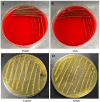Safety evaluation of Weissella confusa SY628 and the effect of its fermentation on the taste and quality of soy yogurt
- PMID: 40438204
- PMCID: PMC12116626
- DOI: 10.3389/fmicb.2025.1567399
Safety evaluation of Weissella confusa SY628 and the effect of its fermentation on the taste and quality of soy yogurt
Abstract
In the global context, the demand for sustainable protein sources is rising, spotlighting plant-based foods, especially legume products. Fermentation is crucial in developing these foods, as it reduces anti-nutritional factors and improves flavor. But the available fermentation strains for plant-based foods are limited. This study aims to address this knowledge gap by evaluating the safety of Weissella confusa SY628 as a fermentation strain and its impact on the quality characteristics of soy yogurt. The safety evaluation of W. confusa SY628 demonstrated that it possessed no hemolytic activity and was sensitive to a variety of antibiotics, no biogenic amines were produced, suggesting an extremely low pathogenic risk. Furthermore, W. confusa SY628 demonstrated enhanced acid and bile tolerance, characteristics that are indicative of its probiotic properties. The fermentation of soy yogurt was conducted using three distinct organisms: W. confusa SY628, commercial bacterial powder CHS, and a combined starter SYCHS composed of the two aforementioned organisms. The physical, and chemical properties and taste quality of the samples were measured. The results demonstrated that in the SYCHS group, after a 21-day storage period, the pH level was 4.49, the total acidity reached 76.77 °T, and the viable count was 5.81 × 107 CFU/mL, indicating good storage stability. The cohesiveness, viscosity, elasticity, and storage modulus of the SYCHS group were found to be significantly higher than those of the other groups, and the internal network structure was found to be stable. In the SYCHS group, the total amino acid content was determined to be 308.57 μg/g, with umami-tasting amino acids accounting for 22.95%. The total fatty acid content was found to be 1818.95 μg/g, with a notably high polyunsaturated fatty acid content, indicating significant nutritional value. The SYCHS group exhibited the highest number of key flavor components. Substances such as 2,3-butanedione exhibited high ROAV values, contributing to a rich flavor profile. In conclusion, the co-fermentation of W. confusa and commercial bacteria significantly improved the overall quality of soy yogurt, providing a theoretical and practical basis for the innovative development of plant-based foods.
Keywords: Weissella confusa SY628; flavor quality; physical and chemical properties; soy yogurt; starter.
Copyright © 2025 Liu, Li, Ye, Zhao and Zhang.
Conflict of interest statement
The authors declare that the research was conducted in the absence of any commercial or financial relationships that could be construed as a potential conflict of interest.
Figures











Similar articles
-
Manufacture and characterization of a novel dairy-free quinoa yogurt fermented by modified commercial starter with Weissella confusa.Food Chem X. 2023 Aug 6;19:100823. doi: 10.1016/j.fochx.2023.100823. eCollection 2023 Oct 30. Food Chem X. 2023. PMID: 37780240 Free PMC article.
-
Insights Into the Role of Leuconostoc Mesenteroides SB1075 Fermentation in Enhancing the Shelf-Life of Soy Yogurt.J Food Sci. 2025 Apr;90(4):e70220. doi: 10.1111/1750-3841.70220. J Food Sci. 2025. PMID: 40285465
-
The Effects of Compound Starter Culture, Sugar, and Soy Milk on the Quality and Probiotic Activity of Milk-Soy Mixed Yogurt.J AOAC Int. 2025 May 1;108(3):380-394. doi: 10.1093/jaoacint/qsaf001. J AOAC Int. 2025. PMID: 39760883
-
Invited review: Advances in yogurt development-Microbiological safety, quality, functionality, sensory evaluation, and consumer perceptions across different dairy and plant-based alternative sources.J Dairy Sci. 2025 Jan;108(1):33-58. doi: 10.3168/jds.2024-25322. Epub 2024 Oct 5. J Dairy Sci. 2025. PMID: 39369892 Review.
-
Literature-based safety assessment of an agriculture- and animal-associated microorganism: Weissella confusa.Regul Toxicol Pharmacol. 2018 Jun;95:142-152. doi: 10.1016/j.yrtph.2018.03.013. Epub 2018 Mar 20. Regul Toxicol Pharmacol. 2018. PMID: 29567328 Review.
References
-
- Abdeldaiem A. M., Ali A. H., Shah N., Ayyash M., Mousa A. H. (2023). Physicochemical analysis, rheological properties, and sensory evaluation of yogurt drink supplemented with roasted barley powder. LWT Food Sci. Technol. 173:114319. doi: 10.1016/j.lwt.2022.114319 - DOI
-
- Ahaotu N. N., Anyogu A., Obioha P., Aririatu L., Ibekwe V. I., Oranusi S., et al. . (2017). Influence of soy fortification on microbial diversity during cassava fermentation and subsequent physicochemical characteristics of garri. Food Microbiol. 66, 165–172. doi: 10.1016/j.fm.2017.04.019, PMID: - DOI - PubMed
-
- Almeida J. M. D., Maffei J. T., Gebara C., Minafra C., Toledo-Silva B., Gonçalves M. C., et al. . (2024). Exploring probiotic potential and antimicrobial properties of lactic acid bacteria from cow's milk, applied. Food Res. 4:100461. doi: 10.1016/j.afres.2024.100461, PMID: - DOI
LinkOut - more resources
Full Text Sources
Miscellaneous

